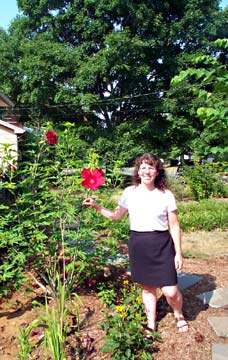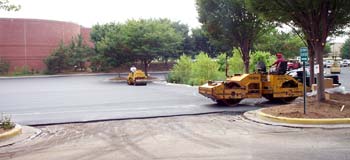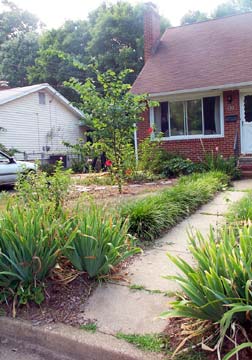|
|
 Every Drop Counts Every Drop Counts
Story & Photos by Sonia Linebaugh
It’s sweating hot. Tan-brown snails have chewed the stems out of the green pattypan squashes. Day lilies have thrown off their dry orange heads. The magenta of cone flowers has faded to the anemic pink of a lipstick not popular since the ’60s. Clouds hold themselves intact, allowing the merest dribs and drabs to fall on the parched young hydrangea.
It will rain again. It must rain again. When it does, I intend to put every precious drop to good use. In June [June 20, Vol. X, No. 25], Juanita Foust taught us how to catch water in a rain barrel and put it to garden’s purpose. I meant to buy a rain barrel but I haven’t done it yet. Now Corinne Reed-Miller shows us how to take one step out of the watering process.
Reed-Miller put a rain garden in her Admiral Heights yard this spring. It looks a lot like a regular garden, but it’s set down into the lawn rather than raised up. “It’s easier than you can imagine,” she says. “I fretted for a month before I did it, but it’s not that different from a regular garden.”
The beauty of a rain garden — this one is alive with black-eyed Susan, coreopsis, bee balm, swamp milk weed and a naturalized Lord Baltimore hibiscus, with room still for blueberry bushes — is not just the view but also the clever use of water. A rain garden grows with rain water directed to it from the house downspout.
The hardest part of making a rain garden is that you have to start with math — fifth grade math. Measurements. Multiplication and division.
Corinne’s Rain Garden
Reed-Miller’s house is a good example:
Picture a small house 30 feet wide and 30 feet deep. Multiply the length of the house by its width to get the square footage: 900.
Divide by the number of downspouts, four in this case: 225. This is about how much of the roof will send water to one downspout.
Plan a garden 30 percent of that size (based on local rainfall averages; trust the experts on this): 67.5. Round that up to an easy number: 70 square feet. That means Reed-Miller’s garden is seven feet by 10 feet.
 |
| Despite this summer’s drought, rainwater keeps a rain garden behind the Heritage Office Complex on Riva Road lush and green. Ann Pearson of Alliance for Sustainable Living points to a low spot in the parking lot curb that brings rainwater runoff directly into the garden. |
Dig your plot about six inches deep. Begin five feet from the nearest foundation because you want the water in the garden, not the basement.
“Don’t bother with a level,” Reed-Miller says. “After you have the garden roughly dug, just lay the hose near the bottom of the downspout, turn the water on and see where the soil is wet, where it puddles and where it needs to go a little deeper.” If necessary, add an extension to your downspout or rainbarrel to help the water flow naturally to the garden.
Add two to three inches of humus or other nutrients. Remember that nutrients are good for your garden but not good running into the storm drains. You may need to use some of the diggings to create a berm on the lower side of you garden.
Add plants. “Common native plants do very well,” advises Reed-Miller. “You want drought-tolerant plants that also don’t mind standing in water for a few days at a time.” In addition to the plants she’s used, Reed-Miller suggests butterfly milkweed, New England aster, Joe-Pye weed, wild bergamot and purple cone flower. All these and more meet the test: drought tolerant but also tolerant of standing water for a day or two at a time. Native plants work best.
Just how does the garden work in real time?
There’s been just one good rain since Reed-Miller put her garden in, she tells me. That May day, she watched anxiously from the living room window as the garden filled but didn’t overflow. If it ever does threaten to overflow, Reed-Miller figures she’ll create a berm directing the water toward her regular flower beds and away from her driveway.
For now this rain garden is a success. It caught and held the rainwater, then slurped it in, watering the plants down to their roots. “Even in this drought, the garden has not been watered other than by rain,” she says.
This sounds like something I can do.
I like the rain garden’s other aspect as well, the hidden benefit to the larger environment. Every bit of water that’s kept and filtered through Reed-Miller’s front yard is slowed down, cleaned and allowed to flow by its own hidden routes into nearby Weems Creek and on to the Bay.
“Holding the first inch of water from a storm keeps 90 percent of pollutants and nutrients out of the Creek,” she says. “Gardens are better filters than lawns. A garden can absorb seven inches of water per hour, grass only two.”
Up-Scaled ‘Bio-retention Areas’
Reed-Miller and I are not alone in appreciating rain gardens. With the persuasion of Anne Pearson of Alliance for Sustainable Living, Anne Arundel County has taken the lead on rain gardens in the parking lot at the Heritage Office Complex.
 |
| Paved parking lots typically return rainwater to the Bay as runoff without benefit of the earth’s leaching magic. Bio-retention gardens, like those behind county offices on Riva Road, reroute rainwater back into the land, where nature cleanses it before it reenters the water table or the Bay. |
“Rain gardens demonstrate the magic ability of the earth to eat pollutants,” says Pearson. Up Broad Creek from the South River, the County created two bio-retention areas, as rain gardens are named at this scale. Surface runoff from the asphalted parking lot is directed into shallow, landscaped depressions that mimic the pollutant removal techniques of nature. Says Pearson, “The natural bio-action of the soil cleans the pollutants.”
The gardens here are appropriately more complex. They’re dug six feet deep, then layered with large gravel, small gravel, sand and compost. But the effects are the same.
“The gardens are a service that allows the earth to function as it is meant to,” says Pearson, “and it puts the beauty back. Humans don’t do well without beauty.”
Ginger Ellis, who oversees the bio-retention project for the county, calls the gardens, “a pretty wonderful thing.”
“We’ve been watching the gardens for close to a year now and there’s a dramatic difference with the raised beds we see elsewhere,” she says. “While those are bone dry, these are lush and green. In a heavy downburst, the gardens fill with water, and by the next day, it has percolated down into the soil.”
An overflow feature keeps excess water from flooding the parking lot.
 |
| The downspouts at Corinne Reed-Miller’s home provide all the water her rain garden needs. |
Spread the Word
Word about rain gardens is spreading. The Center for Watershed Protection has created water-sustaining instructions for homeowners along the South River in partnership with South River Federation. The aim is to keep water laden with fertilizers, earth and car oil out of the storm drains where it rushes pell mell into streams, ripping out fragile shorelines and degrading the water. Presentations on rain gardens, rain barrels, car maintenance and handling pet wastes have been made in Selby on the Bay, Hillsmere and South River Colony.
“We want to tell homeowners what roof and impervious surfaces do to the Bay,” says the Center’s Ann Kitchell. “We want to hit them over the head with some options that work really well, that take that hot water (up to 140 degrees) off the roof, cool it, slow it down and filter it slowly into the ground.”
Rain gardens and rain barrels are the strategies most appealing to homeowners. They’ve got eye appeal. They’re not costly. They’re easy to implement. And they ease the environmental conscience.
“I was surprised,” says Kitchell, “by how many people did not know about rain barrels and rain gardens. There was a lot of enthusiasm.”
I’m enthusiastic too. It looks like rain, and I’m going to miss this opportunity to put every drop to use. I’ll be ready for sure next time. No sweat.
Doing It
If you’re enthusiastic about gardening, about using nature’s resources and about the water quality of our rivers and Bay, there’s help available. The Center for Watershed Protection has fact sheets on rain gardens, green rooftops, lawn conversion to a natural state, fertilizers, pest control, kudzu control, green parking and more: www.cwp.org.
Get a further look at Reed-Miller’s rain garden project at www.WeemsCreek.org, where you’ll find advice, plant suggestions and rain garden sample plans by Homestead Gardens. For informational talks for homeowners’ groups, call Tracy Wroe: 410/721-0661 • [email protected]. Center for Watershed Protection: www.cwp.org.
Copyright 2002
Bay Weekly
|